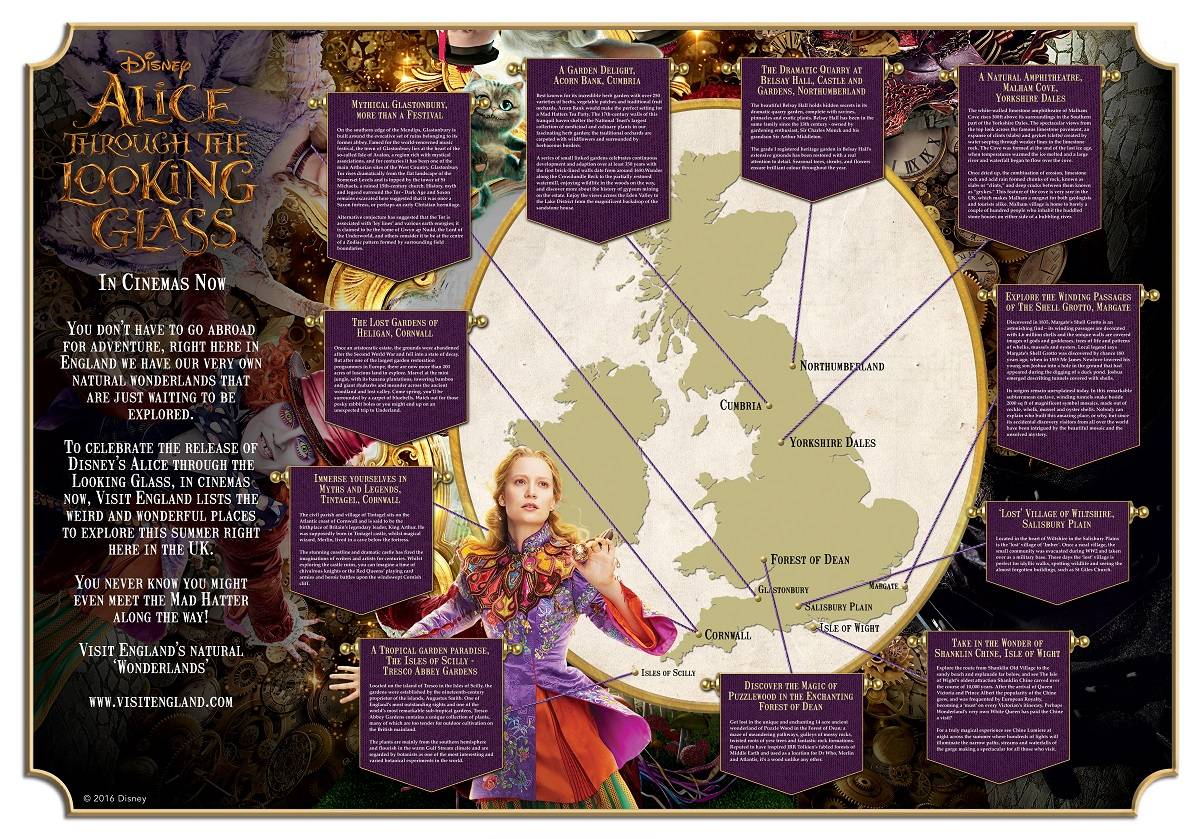Wanderlist: England’s Very Own Wonderlands

You don’t have to go abroad for adventure, right here in England we have our very own natural wonderlands that are just waiting to be explored. To celebrate the release of Disney’s Alice through the Looking Glass, in cinemas now, Visit England put together a list of our very own weird and wonderful wonderlands to explore this summer and you never know you might even meet the Mad Hatter along the way!
Take in the wonder-land of Shanklin Chine, Isle of Wight
Explore the route from Shanklin Old Village to the sandy beach and esplanade far below, and see The Isle of Wight’s oldest attraction Shanklin Chine carved over the course of 10,000 years. After the arrival of Queen Victoria and Prince Albert the popularity of the Chine grew, and was frequented by European Royalty, becoming a ‘must’ on every Victorian’s itinerary. Perhaps Underland’s very own White Queen has paid the Chine a visit? For a truly magical experience see Chine Lumiere at night across the summer where hundreds of lights will illuminate the narrow paths, streams and waterfalls of the gorge making a spectacular for all those who visit.
The dramatic quarry at Belsay Hall, Castle and Gardens, Northumberland
The beautiful Belsay Hall holds hidden secrets in its dramatic quarry garden, complete with ravines, pinnacles and exotic plants. Belsay Hall has been in the same family since the 13th century – owned by gardening enthusiast, Sir Charles Monck and his grandson Sir Arthur Middleton. The grade I registered heritage garden in Belsay Hall’s extensive grounds has been restored with a real attention to detail. Seasonal trees, shrubs, and flowers ensure brilliant colour throughout the year.
Discover the magic of Puzzle Wood in the enchanting Forest of Dean
Get lost in the unique and enchanting 14 acre ancient wonderland of Puzzle Wood in the Forest of Dean; a maze of meandering pathways, gulleys of mossy rocks, twisted roots of yew trees and fantastic rock formations. Reputed to have inspired JRR Tolkien’s fabled forests of Middle Earth and used as a location for Dr Who, Merlin and Atlantis, it’s a wood unlike any other.
A garden delight, Acorn Bank, Cumbria
Best known for its incredible herb garden with over 250 varieties of herbs, vegetable patches and traditional fruit orchards, Acorn Bank would make the perfect setting for a Mad Hatters Tea Party. The 17th-century walls of this tranquil haven shelter the National Trust’s largest collection of medicinal and culinary plants in our fascinating herb garden; the traditional orchards are carpeted with wildflowers and surrounded by herbaceous borders. A series of small linked gardens celebrates continuous development and adaption over at least 350 years with the first brick-lined walls date from around 1650.Wander along the Crowdundle Beck to the partially restored watermill, enjoying wildlife in the woods on the way, and discover more about the history of gypsum mining on the estate. Enjoy the views across the Eden Valley to the Lake District from the magnificent backdrop of the sandstone house.
‘Lost’ Village of Wiltshire, Salisbury Plain
Located in the heart of Wiltshire in the Salisbury Plains is the ‘lost’ village of ‘Imber’. Once a rural village, the small community was evacuated during WW2 and taken over as a military base. These days the ‘lost’ village is perfect for idyllic walks, spotting wildlife and seeing the almost forgotten buildings, such as St Giles Church.
A Tropical garden paradise, The Isles of Scilly – Tresco Abbey Gardens
Located on the island of Tresco in the Isles of Scilly, the gardens were established by the nineteenth-century proprietor of the islands, Augustus Smith. One of England’s most outstanding sights and one of the world’s most remarkable sub-tropical gardens, Tresco Abbey Gardens contains a unique collection of plants, many of which are too tender for outdoor cultivation on the British mainland. The plants are mainly from the southern hemisphere and flourish in the warm Gulf Stream climate and are regarded by botanists as one of the most interesting and varied botanical experiments in the world.
Immerse yourselves in Myths and Legends, Tintagel, Cornwall
The civil parish and village of Tintagel sits on the Atlantic coast of Cornwall and is said to be the birthplace of Britain’s legendary leader, King Arthur. He was supposedly born in Tintagel castle, whilst magical wizard, Merlin, lived in a cave below the fortress. The stunning coastline and dramatic castle has fired the imaginations of writers and artists for centuries. Whilst exploring the castle ruins, you can imagine a time of chivalrous knights or the Red Queens’ playing card armies and heroic battles upon the windswept Cornish cliff.
The Lost Gardens of Heligan, Cornwall
Once an aristocratic estate, the grounds were abandoned after the Second World War and fell into a state of decay. But after one of the largest garden restoration programmes in Europe, there are now more than 200 acres of luscious land to explore. Marvel at the mini jungle, with its banana plantations, towering bamboo and giant rhubarbs and meander across the ancient woodland and lost valley. Come spring, you’ll be surrounded by a carpet of bluebells. Watch out for those pesky rabbit holes or you might end up on an unexpected trip to Underland.
Explore the winding passages of The Shell Grotto, Margate
Discovered in 1835, Margate’s Shell Grotto is an astonishing find – its winding passages are decorated with 4.6 million shells and the unique walls are covered with images of gods and goddesses, trees of life and patterns of whelks, mussels and oysters. Local legend says Margate’s Shell Grotto was discovered by chance 180 years ago, when in 1835 Mr James Newlove lowered his young son Joshua into a hole in the ground that had appeared during the digging of a duck pond. Joshua emerged describing tunnels covered with shells. Its origins remain unexplained today. In this remarkable subterranean enclave, winding tunnels snake beside 2000 sq ft of magnificent symbol mosaics, made out of cockle, whelk, mussel and oyster shells. Nobody can explain who built this amazing place, or why, but since its accidental discovery visitors from all over the world have been intrigued by the beautiful mosaic and the unsolved mystery.
A natural amphitheatre, Malham Cove, Yorkshire Dales
The white-walled limestone amphitheatre of Malham Cove rises 300ft above its surroundings in the Southern part of the Yorkshire Dales. The spectacular views from the top look across the famous limestone pavement, an expanse of clints (slabs) and grykes (clefts) created by water seeping through weaker lines in the limestone rock. The Cove was formed at the end of the last ice age, when temperatures warmed the ice melted and a large river and waterfall began to flow over the cove. Once dried up, the combination of erosion, limestone rock and acid rain formed chunks of rock, known as slabs or “clints,” and deep cracks between them known as “grykes.” This feature of the cove is very rare in the UK, which makes Malham a magnet for both geologists and tourists alike. Malham village is home to barely a couple of hundred people who inhabit the huddled stone houses on either side of a bubbling river.
Mythical Glastonbury, more than a festival
On the southern edge of the Mendips, Glastonbury is built around the evocative set of ruins belonging to its former abbey. Famed for the world-renowned music festival, the town of Glastonbury lies at the heart of the so-called Isle of Avalon, a region rich with mystical associations, and for centuries it has been one of the main Arthurian sites of the West Country. Glastonbury Tor rises dramatically from the flat landscape of the Somerset Levels and is topped by the tower of St Michaels, a ruined 15th-century church. History, myth and legend surround the Tor – Dark Age and Saxon remains excavated here suggested that it was once a Saxon fortress, or perhaps an early Christian hermitage. Alternative conjecture has suggested that the Tor is associated with ‘ley lines’ and various earth energies; it is claimed to be the home of Gwyn ap Nudd, the Lord of the Underworld, and others consider it to be at the centre of a Zodiac pattern formed by surrounding field boundaries.
Alice Through the Looking Glass is in cinemas now.

